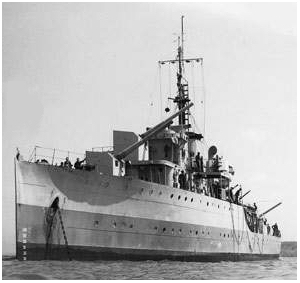HNLMS Flores

Flores
|
|
| History | |
|---|---|
|
|
|
| Name: | Flores |
| Builder: | Mij Feijenoord, Schiedam |
| Laid down: | 13 January 1925 |
| Launched: | 15 August 1925 |
| Commissioned: | 25 March 1926 |
| Identification: | Pennant numbers: F66, N1, F803, A877 |
| Fate: | Sold for scrapping 12 November 1968 |
| General characteristics | |
| Type: | Flores-class gunboat |
| Displacement: |
|
| Length: | 75.6 m (248 ft 0 in) |
| Beam: | 11.5 m (37 ft 9 in) |
| Draught: | 3.6 m (11 ft 10 in) |
| Installed power: |
|
| Propulsion: | 2 shafts, 2 Triple-expansion steam engines |
| Speed: | 15 knots (28 km/h; 17 mph) |
| Complement: | 145 |
| Armament: |
|
| Armour: |
|
HNLMS Flores (Dutch: Hr.Ms. Flores) was a Flores-class gunboat built in the mid-1920s for the Royal Netherlands Navy to patrol the Dutch East Indies.
The ship was laid down on 13 January 1925 at the Mij Feijenoord , Schiedam and launched on 15 August 1925. 25 March 1926 she was commissioned in the Dutch navy. Flores and her sister ship Soemba left the port of Den Helder on 15 June 1926 for the Dutch East Indies. They take a route that led by Seville, Tunis, Port Said, Aden, Colombo and Sabang. She arrived there on 10 August that year.
On 5 March 1927 both ships made a trip to Singapore and Saigon. After a Japanese vessel refused to stop for investigation on 2 October 1937 the ship was seized by the Flores and fired upon, killing two men of the Japanese ship. In 1938 she made a visit to Australia.
Flores was brought back to the Netherlands at the start of World War II where she patrolled home waters until the Germans invaded in 1940. Slightly damaged, she escaped to Britain and was employed as an escort.
During the war Flores operated in the Mediterranean Sea and played an active role in the landings in Sicily, Salerno, Anzio, Garigliano, Gaeta and finally, at the beaches of Normandy in June 1944.
...
Wikipedia
